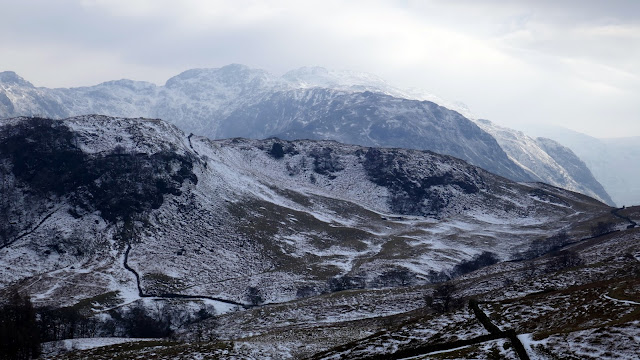This map was created using GPS Visualizer's do-it-yourself geographic utilities.
Please wait while the map data loads...
Route: Grange, Manesty, Hause End, Brandelhow, Skegill Bank, Cat Bells, Mart Bield, Hause Gate, Trap Knotts, Bull Crag, Maiden Moor, Narrow Moor, Minum Crag, High Spy, Wilson's Bield, Tongue Gill, Rigghead Quarries, Castle Crag, High Hows Wood, Borrowdale, Grange
Date: 03/03/2018
From: Grange
Parking: Grange
Start Point: Grange
Region: North Western Fells
Route length: 10.6 miles (17.0 km)
Time taken: 05:15
Average speed: 2.02 mph
Ascent: 1,065m
Descent: 1,072m
Wainwrights on this walk:
Cat Bells (451m), Maiden Moor (576m), High Spy (653m), Castle Crag (290m)
Other Summits: Brandelhow (338m), High Spy North Top (630m)
Other Points of Interest: Terrace path, Cumbria Way
We've been away getting some winter sun recently, hence why you may have noticed a brief lull in my usual exploits. That said, we arrived back in time for a final blast of winter as the so-called 'beast from the east' (a sizeable weather system originating in Siberia), brought the coldest March day on record and more significant snowfall to the majority of the UK.
I had originally planned to get over to North Wales this weekend but the closure of all trans-Pennine routes scuppered those plans. Instead, the low-level route through Skipton to the Lake District remained clear so I packed my bags and winter kit, hopped in the car and drove up to Keswick after work.
My plan was to do a walk I've had in mind for a while - the Cat Bells to High Spy ridge, returning along the Cumbria Way in Borrowdale with the added bonus of an ascent of Castle Crag. After a restless night in Keswick YHA listening to some serious snoring, I arrived in Grange ready for the day ahead.
 |
| The River Derwent at Grange |
 |
| Grange |
 |
| The Manesty road |
 |
| Blea Crag - part of High Spy |
 |
| Climbing up to the terrace path |
 |
| Looking across to Grange Fell |
 |
| A seat with a view |
 |
| The terrace path |
 |
| Cat Bells |
 |
| Bleaberry Fell |
 |
| Starting the climb up Skegill Bank |
 |
| Looking down to Hawse End |
 |
| Stair and Uzzicar below Barrow |
 |
| Cat Bells and Brandelhow |
 |
| The Newlands Valley |
 |
| Cat Bells from Skegill Bank |
 |
| Newlands panorama |
 |
| Brandelhow |
 |
| Causey Pike and Rowling End |
 |
| A toposcope now stands atop Cat Bells |
 |
| A panorama at Cat Bells' summit |
 |
| The Newlands Valley |
 |
| Derwentwater |
 |
| Maiden Moor above Hause Gate |
 |
| Hause Gate |
 |
| Looking back to Cat Bells |
 |
| Sun starts to pick out the drifts |
 |
| Above Bull Crag |
 |
| Maiden Moor's summit |
 |
| Hindscarth |
 |
| Panorama from Maiden Moor |
 |
| The long route to High Spy |
 |
| Skiddaw makes an appearance |
 |
| Drifts at Narrow Moor |
 |
| High Spy's north top |
 |
| North top summit |
 |
| Goat Crag above Borrowdale |
 |
| Looking a little Alpine at Eel Crags |
 |
| Eel Crags |
 |
| Dale Head |
 |
| The panorama above Eel Crags |
 |
| High Spy's summit |
 |
| Dale Head |
 |
| High Scawdel and Dale Head |
 |
| Dale Head |
 |
| Clouds above High Scawdel |
 |
| Dale Head |
 |
| Wilson's Bield |
 |
| Wilson's Bield |
 |
| Looking down Tongue Gill |
 |
| Frozen waterfalls |
 |
| Frozen waterfalls |
 |
| Tongue Gill |
 |
| Rigghead Quarries |
 |
| A stairway from the old mine workings |
 |
| Looking up Tongue Gill |
 |
| Tongue Gill |
 |
| Tongue Gill |
 |
| Rosthwaite and Stonethwaite |
 |
| Glaramara |
 |
| Castle Crag |
 |
| The slippery path up Castle Crag |
 |
| Rosthwaite |
 |
| Rosthwaite and Stonethwaite |
 |
| Upright slate stones in High Hows |
 |
| High Hows quarry |
 |
| memorial on Castle Crag's summit |
 |
| Castle Crag's summit area |
 |
| Castle Crag's summit rocks |
 |
| Looking towards Glaramara |
 |
| Trees atop Castle Crag |
 |
| Castle Crag's slate fortification |
 |
| Great Crag |
 |
| Cumbria Way |
 |
| Millican's Cave? |
Alas, I did not manage to find the cave for three reasons; 1) I only had a vague idea of where it was, 2) I was tired and 3) as I tentatively inspected one of the quarries, a car-sized block of ice fell from the ceiling and smashed not 10m in front of me. This was best saved for another day.
 |
| The River Derwent |
 |
| Tree-lined lanes on the way back to Grange |
 |
| Derwentwater |
 |
| Keswick launch jetties |
 |
| Cat Bells from Friar's Crag |
 |
| Derwent Isle |

No comments :
Post a Comment